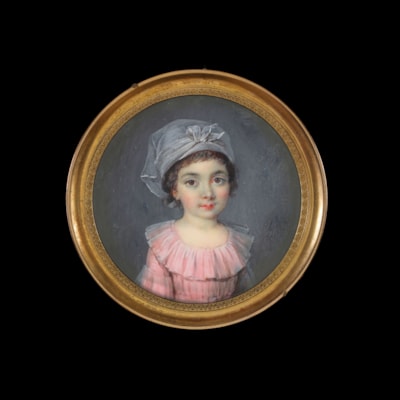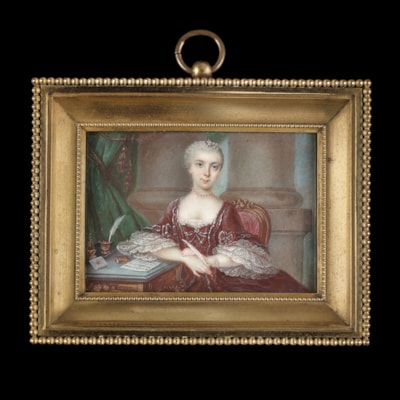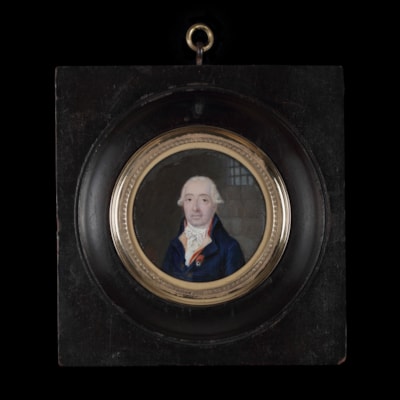FRENCH SCHOOL (18th century)
Portrait miniature of Madame de la Porte (Marie-Anne Pellerin de Painville) (1714-1763), wearing a gold silk shawl over a light pink chemise, pearls in her hair and across her arms, gold silk bow around her neck, with a dog on her lap, playing with a green ribbon
Circa 1750
5.5 x 8.1 cm (2 ¹/₈ x 3 ¹/₄ inches)
Watercolour on ivory (licence number KFMF44UE)
SOLD
Much of Marianne’s life has gone unrecorded, and the only other recorded portrait of her is the aforementioned portrait of her by Jean-Marc Nattier. With the background that she had, however, it is more than likely that she spent her days around the Louis XV’s court at Versailles. She was clearly influenced- at least in style- by the court, especially by the fashions made popular by Madame de Pompadour, maîtresse en titre to the King. Not only does she wear a silk bow around her neck, so often fashioned by Pompadour and other women across Europe in the period, but she has even been depicted with a small black dog, much like those featured in paintings of Madame de Pompadour by Boucher2 and Drouais3.
The scale and shape of this miniature suggest that it would have once been set into a box, a popular setting for miniatures in the period. Furthermore, Marianne appears to be in a state of undress, having only one of her shoulders covered by the silk gown she wears and her chemise exposed, which suggests that it may have been owned by her husband. Such an intimate gift may have been produced for him when he was posted in Canada as Intendant of New France.
Madame de la Porte belonged to the generation before Marie Antoinette, though her style here represents the unfair treatment that the young queen experienced around thirty years later. In 1783, Elizabeth Vigée le Brun (1755-1842) exhibited a portrait of Marie at the Paris Salon. She had painted her in a white muslin dress and a straw hat, and criticisms of the under-dressing of the queen meant that the painting had to be taken down. Not only was the dress simple, comfortable, and far from the heavy silks that the French held pride in producing, but it mimicked the undergarments worn by women in the period. Despite the women of Nattier’s work, and Madame de la Porte in this portrait, having historically been painted in an undressed fashion, now Marie Antoinette was being criticised for doing the same thing. The Chemise à la reine went on to become a popular style, being adopted famously by Emma Hamilton (1765-1815).
In 1792, de la Porte’s son, Arnaud II de la Porte, was sent to the Guillotine. At his trial, the crowds became angry with the judges, who were becoming convinced of his virtue. Unfortunately, this was not enough to save him from being sent to his death. The following year, Marie Antoinette would follow him to the guillotine.
1. Accession number 119.1992.
2. In the Alte Pinakothek, Munich, HUW 18.
3. In the National Gallery, London, NG6440.

shipping notice
Worldwide shipping is included in all prices.
The Limner Company does not accept any responsibility for import duty, this is to be paid by the buyer.
Some stock items contain materials from endangered species which are governed by CITES regulations and will require a permit to export outside of Great Britain. If a certificate of export is required then this will be the responsibility of and paid for by the buyer .
you may also like













